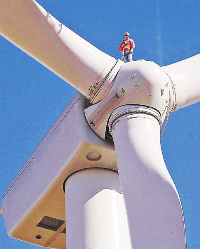From Guest Blogger Joshua Okomo: National Strategies for Green Energy Development
Some simple strategies for national green energy development has worked for Germany, Netherlands and Japan. Nations poor in green energy development can copy and paste. The global least progress in green energy development is still prevalent, some nations think green energy targets set by United Nations is impossible to achieve. State institutions and political leadership in these nations can learn from successful countries.
Germany supported solar energy development by federal state subsidy that encouraged community initiatives, one successful example is the 1000 Roofs Program, provided home owners financial incentives to install photovoltaic systems as a means to lower cost of power and expand consumption of cheap power. Germany has used a Feed–In-Tariff Program that facilitated the integration of solar grids into existing power grids, the nation integrated the EU climate and energy policy into national policy by the Integrated Climate Change and Energy Program.
She has planned to spend Euro 400 million from sale of carbon credits on the EU trading market to invest in low carbon projects such as biomass research. Germany has a renewable energy export initiative, which facilitates contact and communication between German business and business abroad. Through this initiative the Federal Ministry of Economics and Technology launched- Renewable Energy Germany, to facilitate the spread of German technology in the renewable energy sector. A website was launched ;- renewable- made in Germany, this web site provides descriptions of German renewable energy companies and their products, the virtual market place of renewable B2B , operated by the German Greek Chamber of Industry and Commerce, facilitates renewable energy business communication.
The Netherlands approach is simpler, it’s just subsidy. The Dutch government in 2007 passed legislation on The Sustainable Energy Production Incentive, this provides grants to Dutch people who invest in renewable electricity and renewable gas. The grant level is adjusted annually in relation to energy prices. During 2001 the Dutch government implemented Energy Premium (EPR), a subsidy program, and Energy Performance Advice, a free consultation for households and social housing corporations that invest in renewable energy, a program funded by energy taxes.
Japan promotes solar energy development through its New Sunshine Project initiated in 1974. A version of this project was repeated in 1993 to build photovoltaic systems and modernize infrastructure for solar energy. During 2008 Japan launched the Renewable Energy Policy Platform to study and promote renewable energy programs. During 2009 Japanese Ministry of International Trade and Industry announced the new purchase system for solar power generated electricity to promote energy security, this policy required that power companies purchase excess solar power electricity and government specified prices.
Japan created Cool earth 50, an innovative technology roadmap, in 2008 to promote 21 different innovative technologies to reduce GHC emissions, some of the technologies promoted under this scheme include biofuels, solar photovoltaic and hydrogen production. Japanese Ministry of Economy, Trade and Industry provides subsidies for research and development that will increase the propagation of new and renewable energy. This project covers a variety of sectors including electricity, heat and transport.
The Ministry’s New Energy and Industrial Technology Development Organization provides investment for advanced new and renewable energy technologies and facilities, the list includes photovoltaic, wind, solar heat, differential temperature energy, natural gas co-generation, fuel cell, waste generation, use of waste heat and production of fuel for wastes. Japan, Netherlands and Germany are right on the pathway to meet the renewable energy targets 2030, the strategies are too simple to copy and paste.
– Joshua Okomo is Proprietor of Environment Stores & Logistics

